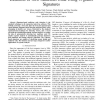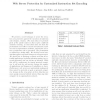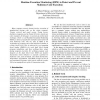CJ
2004
13 years 9 months ago
2004
Digital signatures have been proposed by several researchers as a way of preventing execution of malicious code. In this paper we propose a general architecture for performing the...
DIMVA
2010
13 years 9 months ago
2010
Abstract. In the escalating arms race between malicious code and security tools designed to analyze it, detect it or mitigate its impact, malicious code running inside the operatin...
WORM
2003
13 years 10 months ago
2003
This paper presents DOME, a host-based technique for detecting several general classes of malicious code in software executables. DOME uses static analysis to identify the locatio...
PST
2004
13 years 10 months ago
2004
Signature-based malicious code detection is the standard technique in all commercial anti-virus software. This method can detect a virus only after the virus has appeared and cause...
COMPSAC
2004
IEEE
14 years 1 months ago
2004
IEEE
The current commercial anti-virus software detects a virus only after the virus has appeared and caused damage. Motivated by the standard signature-based technique for detecting v...
ACSAC
2002
IEEE
14 years 2 months ago
2002
IEEE
In this paper we present PEAT: The Portable Executable Analysis Toolkit. It is a software prototype designed to provide a selection of tools that an analyst may use in order to ex...
VEE
2006
ACM
14 years 3 months ago
2006
ACM
One of the most common forms of security attacks involves exploiting a vulnerability to inject malicious code into an executing application and then cause the injected code to be ...
IPPS
2006
IEEE
14 years 3 months ago
2006
IEEE
We present a novel technique to secure the execution of a processor against the execution of malicious code (trojans, viruses). The main idea is to permute parts of the opcode val...
ICSE
2009
IEEE-ACM
14 years 4 months ago
2009
IEEE-ACM
We present a technique for finding security vulnerabilities in Web applications. SQL Injection (SQLI) and crosssite scripting (XSS) attacks are widespread forms of attack in whic...
ICCD
2004
IEEE
14 years 6 months ago
2004
IEEE
1 Many computer security threats involve execution of unauthorized foreign code on the victim computer. Viruses, network and email worms, Trojan horses, backdoor programs used in ...



